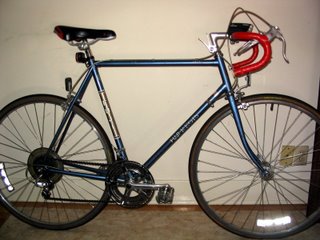Taking the lane
I highly recommend this piece, The Bicycle Driver, by David Smith.
It basically argues that bike lanes are generally dangerous, and that it's usually much safer to take the lane. I've found this to be true, for all the reasons David gives, and one more: you can't always trust drivers to safely judge distances.
That seems to be a major consideration that gets ignored. 2 kinds of drivers really scare me. The first are soccer moms because they're always in a rush, don't pay attention, and are bad at gauging distances, in part because of the huge vans/SUVs they drive. The second are the elderly with bad eyesight who probably shouldn't even be driving in the first place. These drivers are truly dangerous, not because they're aggressive, but because they're clueless.
You're more likely to be seen by these drivers if you're riding smack in the middle of the road. If they misjudge passing distance, you can try to swing to the right quickly. If you're on the bike lane, these drivers almost always pass WAY too close for comfort.
Of course, the usual assholes piss me off too. This morning I rode to school, taking the center of the lane on a two-way street, one lane each plus a middle turning lane. I usually do this, and people pass without a problem using the middle lane. At some point, the middle lane turns into a concrete island, then the road widens into 2 lanes for vehicles. Some guy in a shiny new VW Jetta waited until JUST reaching the island to fucking honk at me. I should have just stayed in the lane for the 5 seconds it would have taken to get to the wider road, but I swung to the right instead. The VW zipped by, along with 2 other cars. The last was a large van that passed inches from my head, and nearly squashed me against the parked cars.
I felt angry at first for the threat to my safety. Then I started to sorry for that driver. I mean, imagine a kind of life where a whole 5 seconds can mean so much to you. 5 seconds! Imagine the stresses and frustrations that you must have, getting to work on time, doing a good job, making the payments on the new car, paying for gas, supporting a family. What powerlessness you must feel in order to honk at a bicyclist to get those precious, precious 5 seconds for yourself. That's probably all he's going to get all day to feel good about himself.
So the more I thought about it, the more I felt, dude, you know what, you can have it.
It basically argues that bike lanes are generally dangerous, and that it's usually much safer to take the lane. I've found this to be true, for all the reasons David gives, and one more: you can't always trust drivers to safely judge distances.
That seems to be a major consideration that gets ignored. 2 kinds of drivers really scare me. The first are soccer moms because they're always in a rush, don't pay attention, and are bad at gauging distances, in part because of the huge vans/SUVs they drive. The second are the elderly with bad eyesight who probably shouldn't even be driving in the first place. These drivers are truly dangerous, not because they're aggressive, but because they're clueless.
You're more likely to be seen by these drivers if you're riding smack in the middle of the road. If they misjudge passing distance, you can try to swing to the right quickly. If you're on the bike lane, these drivers almost always pass WAY too close for comfort.
Of course, the usual assholes piss me off too. This morning I rode to school, taking the center of the lane on a two-way street, one lane each plus a middle turning lane. I usually do this, and people pass without a problem using the middle lane. At some point, the middle lane turns into a concrete island, then the road widens into 2 lanes for vehicles. Some guy in a shiny new VW Jetta waited until JUST reaching the island to fucking honk at me. I should have just stayed in the lane for the 5 seconds it would have taken to get to the wider road, but I swung to the right instead. The VW zipped by, along with 2 other cars. The last was a large van that passed inches from my head, and nearly squashed me against the parked cars.
I felt angry at first for the threat to my safety. Then I started to sorry for that driver. I mean, imagine a kind of life where a whole 5 seconds can mean so much to you. 5 seconds! Imagine the stresses and frustrations that you must have, getting to work on time, doing a good job, making the payments on the new car, paying for gas, supporting a family. What powerlessness you must feel in order to honk at a bicyclist to get those precious, precious 5 seconds for yourself. That's probably all he's going to get all day to feel good about himself.
So the more I thought about it, the more I felt, dude, you know what, you can have it.

